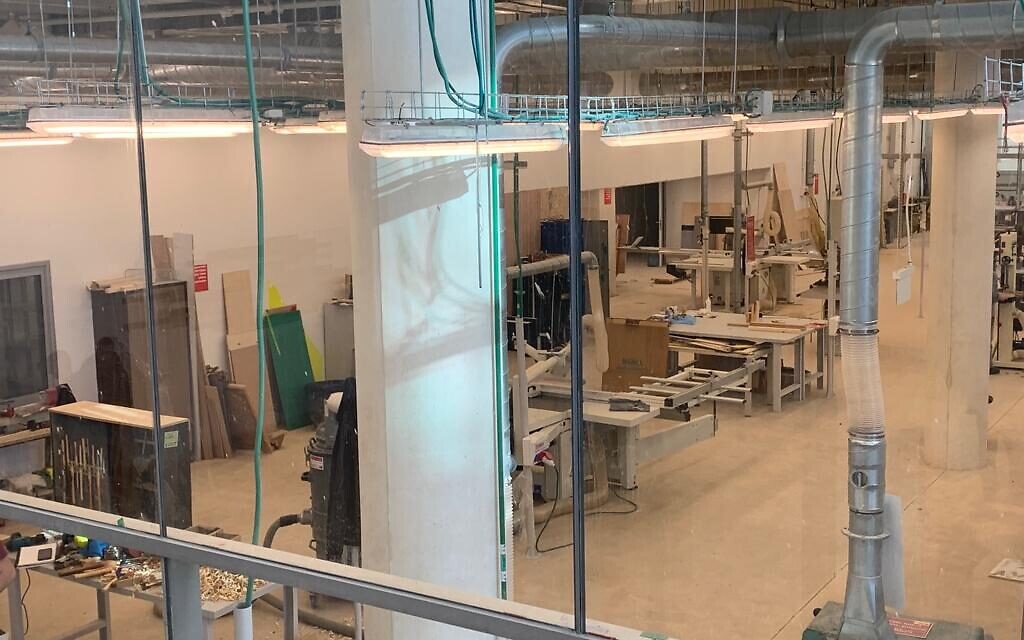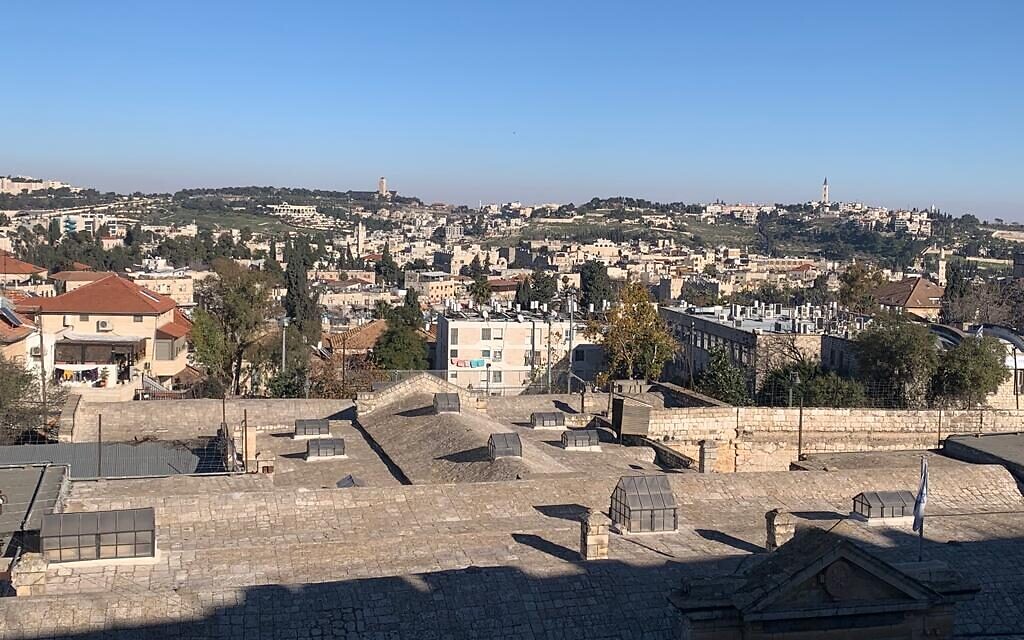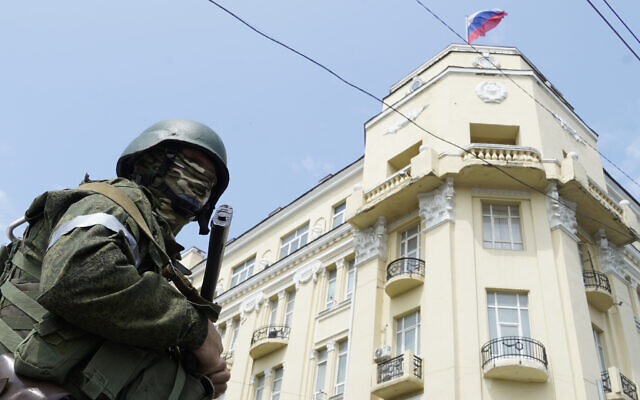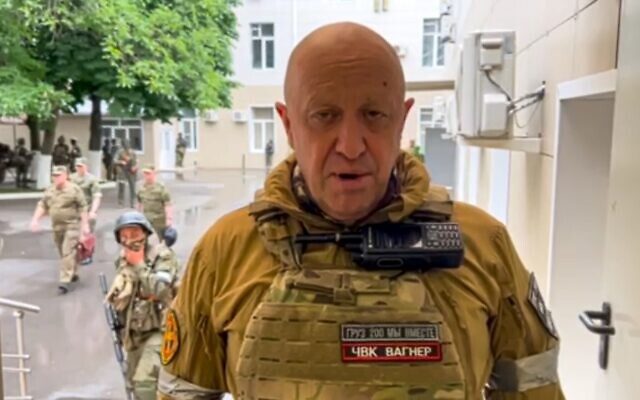Bezalel’s new campus hopes to draw Jerusalem’s many communities into creative space
Israel’s oldest art and design school moves to downtown location, in bid to connect to capital’s diverse population
 View of the rear entrance to the new Bezalel campus, Jerusalem, January 2023. (Courtesy Dor Kedmi)
View of the rear entrance to the new Bezalel campus, Jerusalem, January 2023. (Courtesy Dor Kedmi)- View of neighboring buildings and sites from inside the new Bezalel campus, Jerusalem, January 2023. (Courtesy SANAA Architects)
- Interior view of new Bezalel Design School Campus, Jerusalem, January 2023. Courtesy SANAA Architects.
 Deliberately split level design to fit the Bezalel Campus to its surroundings, January 2023. Courtesy Danielle Nagler.
Deliberately split level design to fit the Bezalel Campus to its surroundings, January 2023. Courtesy Danielle Nagler. Exposed workshop space within the new Bezalel campus, January 2023. (Danielle Nagler)
Exposed workshop space within the new Bezalel campus, January 2023. (Danielle Nagler) View of Jerusalem from the terrace of Bezalel Campus, January 2023. (Danielle Nagler)
View of Jerusalem from the terrace of Bezalel Campus, January 2023. (Danielle Nagler) Entrance to new central campus for Bezalel Academy of Arts and Design, January 2023. (Danielle Nagler)
Entrance to new central campus for Bezalel Academy of Arts and Design, January 2023. (Danielle Nagler)
Bezalel Academy of Arts and Design, one of Israel’s oldest creative and academic institutions, is moving into a brand new campus in the heart of Jerusalem. The new location — more than a decade in the making — aims to increase the role the prestigious design school plays in students’ lives, and encourage them to draw inspiration in their work from Jerusalem and its diverse communities.
Standing on what was once a car park, next door to the Jerusalem municipality and across the road from the Church of the Holy Trinity, the new building blends in despite an intricate combination of concrete and glass. The architects sought to strike a balance, creating an uncompromisingly modern structure that nevertheless works with its surroundings and opens up the academic environment to the population of Jerusalem.
Bezalel was Israel’s first institute of higher education, founded in 1906 in consultation with the father of modern political Zionism, Theodor Herzl. Today, it offers programs across the full spectrum of design disciplines, including fine art, architecture, industrial design, ceramics, jewelry design, fashion, photography, glass design, and robotics.
Many of Israel’s leading creative figures through the years have been Bezalel graduates, including sculptor and experimental artist Yaakov Agam, industrial designer Ron Arad, sculptor Yitzak Danziger, and painter and sculptor Nachum Gutman.
Until recently, the school has lived for the most part alongside the Hebrew University, with each faculty operating separately in its own silo. The new campus offers 42,000 square meters of space (10.5 acres), accommodating workshops, classrooms, gallery space, and an auditorium for almost all disciplines alongside each other.
Bezalel President Professor Adi Stern, who has overseen the planning, the building, and now the move to the new facilities, told The Times of Israel in an interview: “Mount Scopus is not part of the city itself in the same way as the new site. It is more of an ivory tower, a fortress. In our new building, there are no fences or barriers — everyone can see what we do.”
“We are trying to avoid creating an intellectual island, and we want to ensure that our students see themselves as artists and designers in society. It is important to us to connect with Jerusalem — which is very different to Tel Aviv — and offers important challenges for us,” he explained.
The new building frames unique views of Jerusalem, with minimal interference. The proportions have been kept intentionally modest, with the multiple levels following the slope of the site in order to ensure that the building is not overly assertive, surrounded as it is by other landmarks, as well as reflecting the buildings that surround it.
The Japanese architectural firm SANAA took charge of the design for Bezalel’s new home, the company’s debut project in Israel.
Speaking to The Times of Israel from Japan, Riccardo Cannata, one of the lead architects who spent years here overseeing the project, explained that the design team was very conscious of the challenges of building in the heart of Jerusalem.
“Jerusalem has a very strong identity and we wanted the building to “naturally” merge in its surroundings. It was important that the building would not appear as a foreign object,” said Cannata.

But there was also a desire to challenge building norms for the city.
Erez Ella from Tel Aviv-based HQ Architects, the local architects involved in overseeing the delivery of the plans, described how the team developed an alternative to replace the use of stone on external surfaces, as required for all Jerusalem buildings.
“We created a special concrete for this project that combined cement with Jerusalem stone aggregates. This means that the concrete throughout the building shares a color palette with the stone-faced buildings, merging into the Jerusalem landscape, without compromising on modernist style,” explained Ella.
Glass throughout was also used very deliberately to create a sense of openness (rather than students and faculty finding themselves behind solid walls).
Stern said that this is part of an active attempt to break down barriers and foster a multidisciplinary perspective.
“Instead of shutting away work in progress, and allowing each discipline to work within a closed-off space, the new building opens up windows to all parts of the creative process,” he said.
“Workshops are literally exposed to the gaze of other students, and in part to members of the public, who will be able to see the creative process develop.”
Cannata said that the tone of the new building was kept neutral to inform a setting in which “the attention, the action, and the colors” are provided by the students.
Architecture students will continue for the most part to be based in the historic Bezalel building in central Jerusalem, around a 12-minute walk from the new campus.
The other faculties are gradually moving to the new location as builders complete the finishing touches.
The next semester at Bezalel will open with the building fully occupied, though it is likely to take a few more months before viewing spaces and galleries are open to the public.
Stern said the new location for Bezalel underlines a belief in the role of design in civic community and he hopes 2,500 design students in the center of the city, from all backgrounds, understand the importance of using their skills to effect change, better their environments, and help others.
Jerusalem, he said, was like “a living lab, a microcosm of urban environments. We want to ask continually what it means to build in such a city, and to challenge thinking. At times the relationship may be a challenging one, but I believe this is a moment of change for the city center, and that the communities of Jerusalem can inspire us.”
There's no paywall on The Times of Israel, but the journalism we do is costly. As an independent news organization, we are in no way influenced by political or business interests. We rely on readers like you to support our fact-based coverage of Israel and the Jewish world. If you appreciate the integrity of this type of journalism, please join the ToI Community.

We’re really pleased that you’ve read X Times of Israel articles in the past month.
That’s why we started the Times of Israel eleven years ago - to provide discerning readers like you with must-read coverage of Israel and the Jewish world.
So now we have a request. Unlike other news outlets, we haven’t put up a paywall. But as the journalism we do is costly, we invite readers for whom The Times of Israel has become important to help support our work by joining The Times of Israel Community.
For as little as $6 a month you can help support our quality journalism while enjoying The Times of Israel AD-FREE, as well as accessing exclusive content available only to Times of Israel Community members.
Thank you,
David Horovitz, Founding Editor of The Times of Israel










